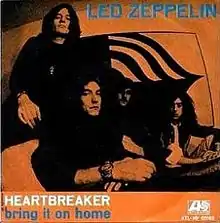Heartbreaker (Led Zeppelin song)
"Heartbreaker" is a song from English rock band Led Zeppelin's 1969 album, Led Zeppelin II. It was credited to all four members of the band, recorded at A&R Recording and Atlantic Studios in New York City during the band's second concert tour of North America, and engineered by Eddie Kramer.[4][5]
| "Heartbreaker" | |
|---|---|
 Italian single picture sleeve | |
| Song by Led Zeppelin | |
| from the album Led Zeppelin II | |
| Released | 22 October 1969 |
| Recorded | 1969 |
| Studio | A&R, New York City |
| Genre | |
| Length | 4:15 |
| Label | Atlantic |
| Songwriter(s) | |
| Producer(s) | Jimmy Page |
"Heartbreaker" opens the second side of the album and features a guitar riff by Jimmy Page. It also includes a spontaneous unaccompanied solo, using a pull-off technique, which was voted the 16th-greatest guitar solo of all time by Guitar World magazine.[5] "Heartbreaker" was ranked number 328 in 2004 by Rolling Stone magazine, in their 500 Greatest Songs of All Time.[6]
Recording
In a 1998 interview with Guitar World, Page commented that the guitar solo was recorded in a different studio, thereby giving a different sound than the rest of the song.[7] He added that this was the first recorded instance of his Gibson Les Paul/Marshall Stack combination.[7] Brett Milano of uDiscover Music rated the guitar solo as one of the 100 all-time greatest.[8]
Influence
"Heartbreaker" is one of the songs featured in Nick Hornby's book 31 Songs. Record producer Rick Rubin has remarked, "One of the greatest riffs in rock. It ["Heartbreaker"] starts, and it's like they don't really know where the "one" is. Magical in its awkwardness."[9] Eddie Van Halen once claimed the "Heartbreaker" solo as the origin behind the tapping technique. In one review with Guitar World, he said:
I think I got the idea of tapping watching Jimmy Page do his "Heartbreaker" solo back in 1971. He was doing a pull-off to an open string, and I thought wait a minute, open string ... pull off. I can do that, but what if I use my finger as the nut and move it around? I just kind of took it and ran with it.[10]
Steve Vai has also commented about it in a September 1998 Guitar World interview: "This one [Heartbreaker] had the biggest impact on me as a youth. It was defiant, bold, and edgier than hell. It really is the definitive rock guitar solo."[11] American band Nirvana covered the song during their first show on 7 March 1987 in Raymond Washington. The cover was only released on the box set With the Lights Out. Led Zeppelin parody/tribute band Dread Zeppelin recorded a reggae-influenced cover of the song with the lyrics from Elvis Presley's "Heartbreak Hotel".
See also
- List of cover versions of Led Zeppelin songs – "Heartbreaker" entries
References
- "Led Zeppelin Biography". Rock and Roll Hall of Fame and Museum. Archived from the original on 29 June 2016. Retrieved 17 February 2014.
their blues-rock approach on such tracks as "Whole Lotta Love," "Heartbreaker" and "Ramble On."
- Williamson, Nigel (2007). The Rough Guide to Led Zeppelin. Rough Guides UK. p. 164. ISBN 978-1-8435-3841-7.
- Rooksby, Rikky (2010). Riffs: How to Create and Play Great Guitar Riffs Revised and Updated Edition (1st ed.). Backbeat Books. p. 81. ISBN 978-1-4768-5547-9.
- Lewis, Dave (6 December 2016). "Led Zeppelin: The Story Behind Led Zeppelin II". Classic Rock. Retrieved 15 June 2017.
- "100 Greatest Guitar Solos: No. 16 "Heartbreaker" (Jimmy Page)". Guitar World. 21 October 2008. Retrieved 15 June 2017.
- "328. Led Zeppelin, 'Heartbreaker'". Rolling Stone. 7 April 2011. Retrieved 4 October 2017.
- Tolinski, Brad; Di Bendetto, Greg (January 1998). "Light and Shade". Guitar World.
- Milano, Brett (11 September 2020). "The Best Guitar Solos: 100 Hair-Raising Moments". uDiscover Music. Retrieved 15 September 2020.
- "Fifty Artists Pick Their Personal Top 10s – Rick Rubin: Led Zeppelin". Rolling Stone. Archived from the original on 11 December 2010.
- Bosso, Joe (20 November 2008). "Van Halen: VH1". Guitar World. Archived from the original on 15 January 2011.
- Kitts, Jeff; Tolinski, Brad (2002). Guitar World Presents the 100 Greatest Guitarists of All Time!. Hal Leonard Corporation. p. 189. ISBN 978-0-6340-4619-3.